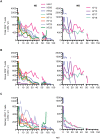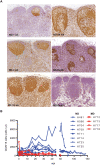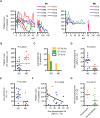Association of progressive CD4(+) T cell decline in SIV infection with the induction of autoreactive antibodies
- PMID: 19360097
- PMCID: PMC2662887
- DOI: 10.1371/journal.ppat.1000372
Association of progressive CD4(+) T cell decline in SIV infection with the induction of autoreactive antibodies
Abstract
The progressive decline of CD4(+) T cells is a hallmark of disease progression in human immunodeficiency virus (HIV) and simian immunodeficiency virus (SIV) infection. Whereas the acute phase of the infection is dominated by virus-mediated depletion of memory CD4(+) T cells, chronic infection is often associated with a progressive decline of total CD4(+) T cells, including the naïve subset. The mechanism of this second phase of CD4(+) T cell loss is unclear and may include immune activation-induced cell death, immune-mediated destruction, and regenerative or homeostatic failure. We studied patterns of CD4(+) T cell subset depletion in blood and tissues in a group of 20 rhesus macaques inoculated with derivatives of the pathogenic SIVsmE543-3 or SIVmac239. Phenotypic analysis of CD4(+) T cells demonstrated two patterns of CD4(+) T cell depletion, primarily affecting either naïve or memory CD4(+) T cells. Progressive decline of total CD4(+) T cells was observed only in macaques with naïve CD4(+) T cell depletion (ND), though the depletion of memory CD4(+) T cells was profound in macaques with memory CD4(+) T cell depletion (MD). ND macaques exhibited lower viral load and higher SIV-specific antibody responses and greater B cell activation than MD macaques. Depletion of naïve CD4(+) T cells was associated with plasma antibodies autoreactive with CD4(+) T cells, increasing numbers of IgG-coated CD4(+) T cells, and increased incidence of autoreactive antibodies to platelets (GPIIIa), dsDNA, and phospholipid (aPL). Consistent with a biological role of these antibodies, these latter antibodies were accompanied by clinical features associated with autoimmune disorders, thrombocytopenia, and catastrophic thrombotic events. More importantly for AIDS pathogenesis, the level of autoreactive antibodies significantly correlated with the extent of naïve CD4(+) T cell depletion. These results suggest an important role of autoreactive antibodies in the CD4(+) T cell decline observed during progression to AIDS.
Conflict of interest statement
The authors have declared that no competing interests exist.
Figures












References
-
- Hazenberg MD, Otto SA, van Benthem BH, Roos MT, Coutinho RA, et al. Persistent immune activation in HIV-1 infection is associated with progression to AIDS. AIDS. 2003;17:1881–1888. - PubMed
-
- Ullum H, Lepri AC, Victor J, Skinhoj P, Phillips AN, et al. Increased losses of CD4+CD45RA+ cells in late stages of HIV infection is related to increased risk of death: evidence from a cohort of 347 HIV-infected individuals. Aids. 1997;11:1479–1485. - PubMed
-
- Ho Tsong Fang R, Khatissian E, Monceaux V, Cumont MC, Beq S, et al. Disease progression in macaques with low SIV replication levels: on the relevance of TREC counts. AIDS. 2005;19:663–673. - PubMed
-
- Mattapallil JJ, Letvin NL, Roederer M. T-cell dynamics during acute SIV infection. AIDS. 2004;18:13–23. - PubMed
Publication types
MeSH terms
Substances
Grants and funding
LinkOut - more resources
Full Text Sources
Other Literature Sources
Research Materials

